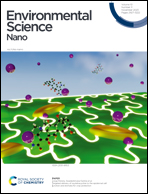Simultaneous reduction of arsenic and lead bioaccumulation in rice (Oryza sativa L.) by nano-TiO2: a mechanistic study†
Abstract
Heavy metals with opposite charges (e.g., arsenic and lead) generally have opposite environmental behaviors. Nano-enabled strategies to concurrently inhibit their accumulation in crops remain elusive. Here, nano-TiO2 with an anatase (NAT) or rutile (NRT) structure or bulk TiO2 (BT) was used at 10, 100, and 1000 mg L−1 to amend hydroponic rice seedling systems co-contaminated with arsenic (1 mg L−1) and lead (2 or 10 mg L−1) for mechanistic understanding of contaminant interactions. A simultaneous decrease of arsenic and lead bioaccumulation in rice plants and their retention in the root iron plaque were achieved by significant metal sorption to 1000 mg L−1 NAT and NRT. The arsenic uptake mitigation by NRT (82–93%) was much higher than that by NAT (46–65%), while their lead uptake inhibition was comparable (47–89% for NRT vs. 37–78% for NAT). When the lead/arsenic exposure ratio increased, 100 mg L−1 nano-TiO2 and BT at all doses also significantly reduced the root metal content, attributable to their enhanced sorption on TiO2 and iron plaque. TiO2 amendment posed no risk to the plant and completely alleviated oxidative stress from exposure thus restoring it to healthy control levels. Our findings highlight the potential application of 1000 mg L−1 nano-TiO2, particularly with a rutile structure, for combined arsenic and lead reduction in rice, effectively enhancing both food safety and human health.



 Please wait while we load your content...
Please wait while we load your content...